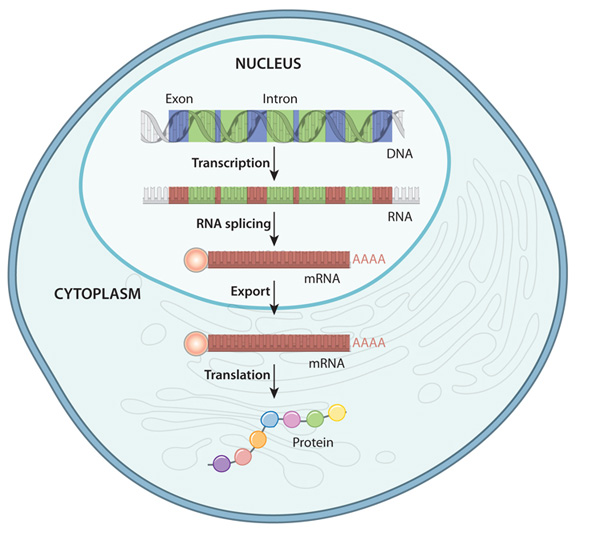What Are Two Ways in Which Repressors Can Interfere With Transcription?
The amounts and types of mRNA molecules in a cell reverberate the function of that prison cell. In fact, thousands of transcripts are produced every 2nd in every cell. Given this statistic, information technology is not surprising that the primary control betoken for factor expression is usually at the very outset of the protein production process — the initiation of transcription. RNA transcription makes an efficient control point considering many proteins tin be made from a single mRNA molecule.
Transcript processing provides an additional level of regulation for eukaryotes, and the presence of a nucleus makes this possible. In prokaryotes, translation of a transcript begins before the transcript is consummate, due to the proximity of ribosomes to the new mRNA molecules. In eukaryotes, however, transcripts are modified in the nucleus before they are exported to the cytoplasm for translation.
Eukaryotic transcripts are besides more complex than prokaryotic transcripts. For case, the chief transcripts synthesized by RNA polymerase contain sequences that will non be part of the mature RNA. These intervening sequences are chosen introns, and they are removed earlier the mature mRNA leaves the nucleus. The remaining regions of the transcript, which include the protein-coding regions, are chosen exons, and they are spliced together to produce the mature mRNA. Eukaryotic transcripts are too modified at their ends, which affects their stability and translation.
Of course, at that place are many cases in which cells must answer quickly to changing environmental atmospheric condition. In these situations, the regulatory control betoken may come up well after transcription. For example, early development in well-nigh animals relies on translational control because very footling transcription occurs during the first few jail cell divisions later fertilization. Eggs therefore contain many maternally originated mRNA transcripts equally a fix reserve for translation after fertilization (Effigy 1).
On the degradative side of the residual, cells can rapidly conform their protein levels through the enzymatic breakdown of RNA transcripts and existing protein molecules. Both of these actions result in decreased amounts of sure proteins. Frequently, this breakdown is linked to specific events in the cell. The eukaryotic cell bicycle provides a good example of how protein breakup is linked to cellular events. This cycle is divided into several phases, each of which is characterized past distinct cyclin proteins that act as key regulators for that stage. Before a cell can progress from i phase of the prison cell cycle to the next, it must degrade the cyclin that characterizes that particular phase of the bike. Failure to degrade a cyclin stops the cycle from continuing.

Figure ane: An overview of the menstruation of information from DNA to protein in a eukaryote
Starting time, both coding and noncoding regions of DNA are transcribed into mRNA. Some regions are removed (introns) during initial mRNA processing. The remaining exons are then spliced together, and the spliced mRNA molecule (cherry-red) is prepared for export out of the nucleus through addition of an endcap (sphere) and a polyA tail. Once in the cytoplasm, the mRNA can be used to construct a poly peptide.
Source: https://www.nature.com/scitable/topicpage/gene-expression-14121669/
Postar um comentário for "What Are Two Ways in Which Repressors Can Interfere With Transcription?"